Key Takeaways
- This case study of Indiana University's e-text initiative reports on the participation levels and motivations of instructors in engaging with digital textbooks.
- Instructors can benefit from e-text features, including real-time reading and engagement analytics, note-sharing with students, and ability to integrate links, annotations, and multimedia materials into study materials.
- The findings from this study suggest that instructors play an important role in e-text adoption by modeling active e-text use and creating meaningful interaction around the content.
- Simply put, when instructors engage with e-texts, so do their students.
Serdar Abaci, Educational Research and Evaluation Specialist, Learning Technologies, Indiana University; Anastasia S. Morrone, Associate Vice President, Learning Technologies, and Dean for IT, Indiana University–Purdue University Indianapolis; and Alan R. Dennis, John T. Chambers Chair of Internet Systems, Kelley School of Business, Indiana University
Although still major tools for higher education, textbooks often get in the way of learning because students cannot afford to buy every textbook assigned in their courses. Digital books promised a cost-effective and portable alternative; however, the adoption of digital textbooks in higher education has been slower than predicted mainly due to their high cost relative to paper textbooks.1 Students prefer buying a used paper textbook and reselling it after the course is over, which is cheaper than buying a typical e-text and losing access after a limited time.
Many universities and colleges are trying various approaches to lower the cost of textbooks, which includes piloting different models of e-text adoption. Cognizant of price and access concerns, in 2009 Indiana University (IU) used its experience with volume software purchasing to develop a similar model for university-level e-text agreements with publishers. In this model, when the course instructor decides to use an e-text, all students in a course section pay a required e-text fee and get access to digital course materials. Students can access their e-texts from multiple devices such as laptops, tablets, or mobile phones, both online and offline, as long as they remain enrolled in the university. After piloting this model for four consecutive semesters, Indiana University moved forward and implemented a full-scale e-text initiative. Following the IU e-text model, several institutions have collaborated with Internet2 and EDUCAUSE to pilot e-text adoption.2
The new generation of e-texts and e-reading platforms such as the one used in IU's e-text initiative allow instructors to communicate with students through shared highlights and notes. Instructor engagement with e-texts is likely to enhance student experience, but existing research on e-texts primarily focuses on students' attitudes toward and experience with e-texts and the effects of e-texts on learning while overlooking instructors' experience and attitudes. This article reports on the findings of the two-year pilot phase of Indiana University's e-text initiative as they relate to instructors' influence on e-text use. It also presents the findings of a follow-up case study examining instructors' motives for adopting e-texts and how instructors use the enhanced features of e-texts.
Indiana University's E-Text Initiative
Indiana University is a large research institution with more than 110,000 students enrolled across eight campuses in the state of Indiana. As part of its second Information Technology Strategic Plan, IU started an e-text initiative in fall 2009 with the following objectives:
- Bring down the cost of instructional materials for students
- Provide high-quality instructional materials
- Enable new tools for teaching and learning
- Shape the terms of sustainable models that work for all the stakeholders involved
The e-text initiative was a pilot program during its first two years. At this stage, IU had agreements with five publishers for e-text titles and Courseload to provide a unified reading platform to access, read, and annotate e-texts from different publishers. The Courseload e-reading platform, which was integrated with the university's learning management system, allowed instructors and students to access all of their e-texts without having to download separate e-reader programs or create multiple accounts. IU subsidized e-text costs while evaluating the program in the first two semesters, whereas students paid a required e-text fee in the last two semesters of the pilot.
IU's e-text initiative does not offer any direct incentive to participating instructors. However, instructors can benefit from the advantages of using an e-text, including real-time reading and engagement analytics, the ability to share notes with students, and the ability to integrate links, annotations, and multimedia materials into study materials. If an instructor decides to use an e-text, students who register for the course pay a required e-text fee and gain access to the text before the semester starts. Students cannot opt out of using the e-text, but they can print the entire book or purchase a print-on-demand copy if they prefer a paper version. Students' cost savings with e-texts typically outweigh the net cost of buying a used paper textbook and reselling it at the end of semester.
IU's e-text initiative and institution-level agreements with publishers addressed several concerns raised by instructors and students regarding e-text adoption3:
- High cost: IU's agreements with publishers achieved significant cost savings. Each student pays about one-third of the paper textbook's retail price for a digital-only e-text.
- Printing restrictions: Students can print as many pages as they want; they can also purchase a print-on-demand copy for a modest additional fee.
- Limited access: Students maintain access to their e-texts as long as they are enrolled as a student at the university.
- Access on multiple devices: Students can access all of their e-texts on multiple devices online, and they can read offline on laptop and desktop computers.
Starting in spring 2012, IU fully implemented the e-text initiative across its eight campuses. Currently, IU has agreements with fifteen publishers including McGraw-Hill, Pearson, Cengage Learning, Elsevier, MacMillan, Sage, John Wiley & Sons, Harvard Business School Publishing, Flat World Knowledge, GlobaLens, HEC Montreal, IU Press, Responsive Learning Technologies, SimProfessionals, and W. W. Norton. Availability of textbook titles is subject to these publishers' IU e-text catalog, but instructors can request additional titles from the publishers if they are not available.
In the first semester of the full implementation, 4,595 students in 136 unique course sections used 152 different e-text titles, which resulted in their saving $559,347 in textbook costs. At the end of the first year — which includes spring, summer, and fall semesters — the number of course sections adopting e-texts reached 359, with 721 different e-text titles. Since then, year-to-year changes within each semester have shown solid increases (figure 1). Most recently, in fall 2014 instructors in 607 unique course sections opted to use e-texts, a 69 percent increase from fall 2013.
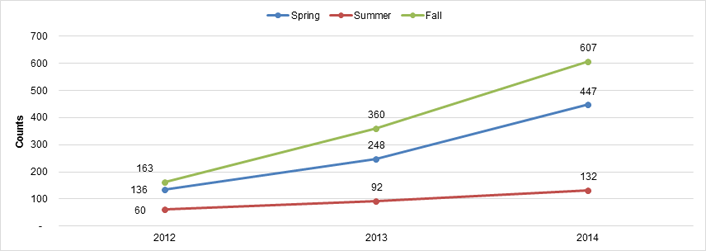
Figure 1. Number of course sections adopting e-texts
This consistent upward trend is also reflected in the number of students using e-texts and their cost savings. Overall, a total of 67,913 students have used e-texts at Indiana University (figure 2), and the program has achieved close to $8 million in saved textbook expenses for participating students (figure 3).
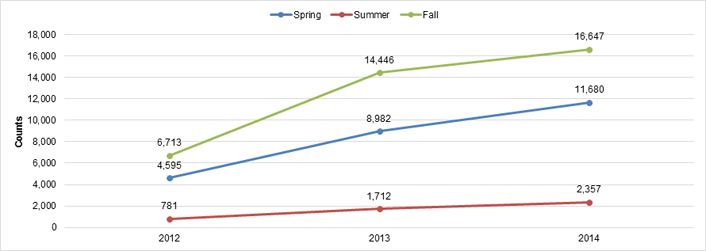
Figure 2. Number of students using e-texts
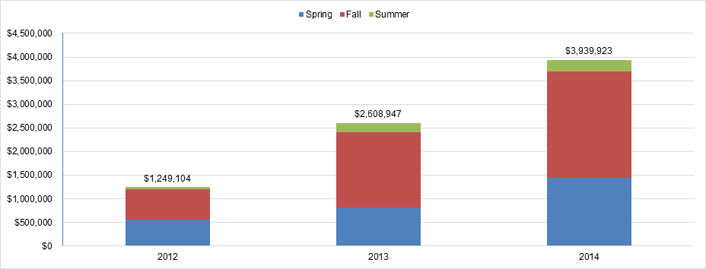
Figure 3. Cost savings for students participating in IU's e-texts initiative
Summary of Findings from IU's E-Text Pilot
During the pilot phase of IU's e-text initiative, we collected data from courses in which the course instructor opted to use an e-text. From spring 2010 until fall 2011, we were able to study actual e-text usage by approximately 2,200 students in 28 courses using the Courseload e-reading platform logs and a survey [http://etexts.iu.edu/files/Etexts_at_IU_StudentSurvey.pdf] of self-reported reading behavior, perceived learning, and future preferences.
The final sample included 1,081 students from 18 sections of 11 different courses, for a response rate of 49 percent. Courses in the pilot study ranged from business to history, language, telecommunications, psychology, and astronomy. These courses also varied in terms of level and class size (figure 4).

Figure 4. Course demographics (n = 18 course sections)
The median age of students in the pilot courses was 21. More men than women completed the survey. The majority of survey respondents were third- or fourth-year students, and a large number of students reported higher than a 3.0 cumulative GPA (figure 5).

Figure 5. Student demographics (n = 1,081 students)
An Instructor's Active Use of E-Texts Drives Student Use
Active e-text use in a course refers to how instructors use e-texts inside and outside the classroom. In-class activities may involve presenting portions of an e-text — such as a graphic, section, or paragraph — or referring to e-text content as part of class discussion or a group activity. Beyond the classroom, instructors may use e-texts by sharing their annotations, highlights, and notes on the e-text with their students to guide class preparation and content review for exams.
We asked students if their instructors actively used e-texts in their courses. Students from the same course sections had varying responses to this question, which made it difficult to identify which instructors actively used e-texts. For the purpose of comparison, we dichotomized student responses, collected on a five-level Likert-type scale, by combining agree and strongly agree into "active instructor use" and combining the other three points on the scale (neutral, disagree, and strongly disagree) into "no active instructor use." After these adjustments, 46 percent of the students reported that their instructor made active use of e-texts, while the other 54 percent believed otherwise.
Self-Reported Reading, Annotating, and Perceived Learning
Our survey asked students if they read more, less, or the same amount of the assigned text with e-texts compared to what they would have read with paper textbooks. After grouping student responses based on instructor e-text usage (active use vs. no active use), we found that 53 percent of those in the active group stated that they read the same amount or more. In comparison, only 34 percent of those in the group with no active instructor use stated that they read the same amount or more (figure 6). That is, more students in an active e-text–using classroom read more of the assigned text compared to their counterparts in a classroom in which the e-text was not used actively.
With paper textbooks, students typically highlight and take marginal notes to help them prepare for class or review for exams. However, they may also refrain from doing so if they rent a paper textbook or want to resell it at a higher value. In this pilot study, the Courseload e-reading platform allowed students to highlight, annotate, and make notes on e-texts, with no restrictions. We then asked students if they used these features more, less, or the same amount compared to highlighting and notes they would have made on paper textbooks. Forty-seven percent of the students in courses with active e-text use reported that they used annotation features the same amount or more with e-texts compared to paper textbooks. This ratio was 40 percent in courses without active e-text use (figure 6). This suggests that students are likelier to highlight and annotate their e-text if their instructor actively uses the e-text compared to students whose instructor does not use the e-text actively.
Finally, we asked students if they learned more, the same, or less from using e-texts compared to what they would normally learn from paper textbooks. It is important to note that learning in this study was not measured by any indicators; this question targeted students' self-perceived comparison of learning between the two types of texts. The difference between students learning the same or more and students learning less was significantly lower when the instructor actively used e-texts in the course. This gap widened when the instructor did not use e-texts actively (figure 6). In other words, more students in an active e-text–using class believed that they learned the same amount or more from their e-texts compared to paper textbooks.
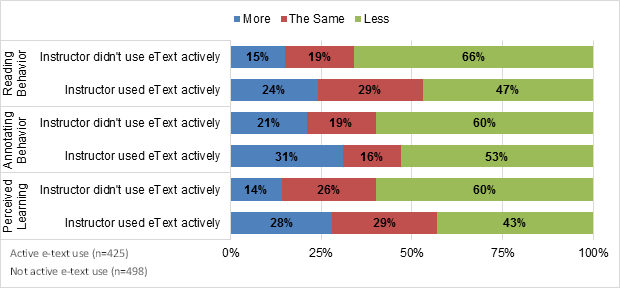
Figure 6. Students' reading, annotating behavior, and perceived learning based on instructor e-text use
Perceived Usefulness of Instructor Notes and Highlights
One distinguishing feature of e-texts in this pilot study was that the Courseload e-reading platform enabled instructors to annotate, highlight, and make notes on an e-text and to share these with the students. Instructor notes and highlighting can increase interaction with students beyond class time and guide students to the most important content. We asked students if instructor annotations and highlights were useful for studying. The majority of students (54 percent) found instructor notes and highlights useful when the instructor used the e-text actively in the course. This ratio was significantly lower (21 percent) when the instructor did not use the e-text actively (figure 7).

Figure 7. Perceived usefulness of instructor notes and highlights
Conclusions of the IU e-text Pilot Studies
According to students, only half of the instructors actively used e-texts in their courses. As already shown, an instructor's active use of e-texts in a course affected student experiences with e-texts. All of these comparisons were statistically significant according to Pearson's chi-square test for independence. That is, student experiences of e-texts were more positive if they felt an instructor actively used e-texts in the class and shared annotations with students. This finding was also supported by the fact that 70 percent of the surveyed students chose instructor highlights and notes as an important factor in preferring e-texts over paper textbooks (figure 8). When instructors are not actively using the e-text, our findings align with existing research, in that students read more with paper textbooks and they underutilize available features of e-texts.4 However, instructors are key stakeholders in formal education regardless of the textbook's medium. As our study suggests, they are also instrumental in guiding student behaviors and attitudes regarding e-text use to enhance learning benefits.
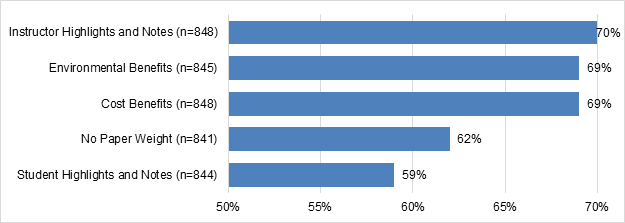
Figure 8. Important factors in preferring e-texts over paper textbooks
Although two other pilot studies5 also highlight the critical role of instructor e-text adoption and use of enhanced features (i.e., shared highlights and annotations) in student e-text experiences, no research has examined instructor motives for adopting e-texts or how instructors use e-texts in their courses. At IU, we had a unique opportunity to address this gap by interviewing instructors who actively used an e-text in their course for at least two semesters.
Follow-up Study: Why and How Do Instructors Use E-Texts?
Early versions of e-texts, also known as page fidelity e-texts, were pdf or scanned image versions of the paper textbooks.6 Thus, use of these e-texts did not differ from use of traditional paper textbooks. In contrast, newer reflowable e-texts offer features such as search, highlighting, annotation, or web linking, which allow interaction between instructor and students.7 Consequently, instructors might facilitate student engagement with course readings when they use e-text features. As data from our pilot studies showed, an instructor's active use of e-texts has a positive impact on students' reading and note-taking behavior with e-texts. However, little research examines instructors' actual use of e-texts. One survey study indicated that instructors used digital library books as textbooks; however, it did not discuss how instructors used the e-texts in the context of teaching.8 Another case study examined instructors using e-texts in a university setting. However, this case study focused on policy issues related to e-texts and how instructors worked with publishers to create digital textbooks rather than their actual e-text usage in a class.9
Given the lack of research in this area and our findings from the pilot data, we designed a collective case study to understand instructor motivations for adopting e-texts, as well as instructor use of e-texts and their enhanced features. A collective case study is likelier to lend itself to valid generalization. With purposive sampling, we targeted instructors who were using enhanced e-text features known as markups (i.e., highlights, annotations, page notes), and we aimed for maximum variation in markup type, class size, subject area (discipline), and course level.10 Five of the instructors we invited to our study agreed to participate. We conducted semistructured interviews that took 20–30 minutes to complete. The pilot studies' findings guided the questions asked in the interviews.
All five instructors (four female and one male) have more than 10 years of teaching experience at IU, and all taught at least two semesters of the same course with e-texts. Their courses included a 300-level nursing course, a 200-level public health course, an introductory psychology course, a quantitative analysis course, and a telecommunications management course. Course sizes ranged from 18 to 130 students. Four were traditional face-to-face courses; one was a blended face-to-face and online course.
Instructor Motives and Perceived Advantages of E-Texts
We asked instructors to explain their reasons for adopting e-texts. Collectively, they cited five different reasons for switching to e-texts for their courses:
- Guaranteed access to texts by all students when semester starts. For courses using e-texts at IU, students get access to e-texts before classes begin. A mandatory e-text fee is billed directly to their bursar account. Four of the five instructors stated that guaranteed access to the e-text was a key reason to switch to an e-text from a paper textbook.
- Ability to share highlights and notes with students. The Courseload e-reading platform allows instructors to highlight the text and add notes, which they can share with students. This e-text feature is an enhancement over paper textbooks in that instructors can communicate content-related information to students. All five instructors used the highlight and annotation features. Two noted that this, in particular, was one of their motives for using e-texts instead of paper textbooks.
- Ability to use the text more effectively during class time. All five instructors viewed the use of e-texts in class as an advantage over paper textbooks. Having the book available in digital format makes it more convenient for the instructor to reference specific content that can be found using the search function. Given that all students have access to e-texts on their mobile devices, instructors can make greater use of the e-texts for class activities.
Instructor 1 explained: "We were using the textbook [before switching to the e-text], but it wasn't something that students brought to class. We were able to bring up different parts of the e-text during class and use it during class exercises."
Said Instructor 5: "If someone brings up a question in class about the reading, we can actually go to the page that they are talking about."
- Ability to assess student engagement with readings. The Courseload e-reading platform provides instructors with data on student reading and note-taking behavior, which is not possible with paper textbooks.
Instructor 4 stated that she wanted to make sure that she could see whether "1) students are reading, and 2) when they weren't reading, I have the availability of using the e-text in class to reinforce certain things and to encourage their reading a bit more."
- Cost advantage for students. High textbook prices are also a concern for instructors, as they feel "financial compassion to the students" in Instructor 5's terms. Instructor 5 cited high textbook prices as the primary reason for adopting e-texts. He first adopted an e-text for his advertising course because the textbook for the course was very expensive. He then switched to e-texts for his other courses.
Instructor Use of Enhanced E-Text Features
As described earlier, the Courseload e-reading platform allows instructors to make highlights and notes on e-texts and share these markups with their students. All five instructors in our study used these markup features to varying degrees, as presented in table 1. Instructors also unanimously stated that they learned to use these features on their own by trial-and-error, although online resources and in-person help were available to them.
Table 1. Instructor e-text markup use by the numbers
|
Instructor |
E-Text Markups |
|||
|---|---|---|---|---|
|
Highlights |
Annotations |
Page Notes |
Response to Questions |
|
|
Instructor 1 |
14 |
231 |
0 |
0 |
|
Instructor 2 |
230 |
12 |
0 |
0 |
|
Instructor 3 |
483 |
33 |
62 |
0 |
|
Instructor 4 |
164 |
41 |
0 |
0 |
|
Instructor 5 |
705 |
43 |
0 |
7 |
Highlights
For the interviewed instructors, highlights usually meant guiding students and drawing attention to key concepts in the text. Instructor 1 had the least number of highlights among the five instructors. She explained that she used highlights to emphasize the annotations she made in the e-text; she did not use highlights alone. All other instructors used the highlighting feature for marking the sections that they consider important for both pre-class activities such as quizzes and in-class discussion and activities. Instructor 5 had the highest number of highlights, in part because his class was the first of a three-course sequence; thus, he highlighted sections that are important not only for his course but also for the two consequent courses.
Instructor 3 noted: "If they are going to highlight anyway, I want them to highlight things that they either frequently don't get right or things that I really need them to know."
Although the instructors intended to guide students by sharing highlights on the e-texts, they were also concerned that students would only read the highlighted sections and skip the rest of the assigned readings. To minimize this behavior, instructors typically explained their purpose in highlighting the e-text in the first session of the class.
Instructor 4 stated: "I don't want them to think that just because I highlighted something, that is the only thing they should read in the book. That actually has to be reinforced quite a bit."
Instructor 5 noted: "Quite possibly [students] just skim the chapter and look at my highlights, which is a drawback of e-texts. At the same time they know what I think is particularly important for this [program] curriculum."
Shared Notes (Annotations, Page Notes, and Response to Questions)
In Courseload, instructors can share notes in three different ways: annotations on sections of a page, notes for an entire page, or as a response to a student's question related to e-text content (see figure 9). The instructors in our study generally used this feature to provide additional relevant content such as hyperlinks to online resources, to explain alternative perspectives on a particular topic, or to clarify their use of specific terminology as compared to the book's use of the terminology.
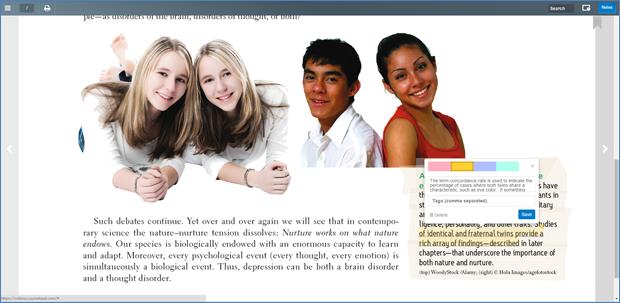
Figure 9. Instructor-added definition
Instructor 1 uses annotations to elaborate on the content: "It might be a short paragraph that extends a particular sentence in the book that we may have a brief discussion about in class. I can get churned out with just an annotation in the reading."
Instructor 3 offers updates and additional perspectives with annotations: "If I notice things that are either out of date or biased, I try to add some updated information or I try to provide alternative viewpoints there."
Instructor 5 provides links to current related news and events using annotations: "If the e-text mentions a topic, say in the cable industry, and I know the headlines of today's NY Times has an article on exactly that, I'd like to include a link to that."
Only Instructor 5 used the responses to questions feature. He told his students in the first class that this is the way he expects students "to communicate questions to [him] when there is contradiction in the textbook." Similarly, Instructor 4 mentioned telling her students that they can ask questions through the e-text, although her students did not take advantage of this option.
In summary, while the volume and purpose of instructor markups varied, these markups provided an additional channel of communication between instructors and students. Communicating the same information is possible by other means (e.g., additional notes in the syllabus, extended discussion in the classroom, or asynchronous messages through e-mail or discussion boards), but e-text markups are more convenient for the instructor and more contextualized for the students.
Impact of E-Text Use on Teaching Pedagogy
We were also interested in whether instructors' teaching style and pedagogy changed as a result of using e-text. They stated that they did not make changes in their teaching pedagogy other than sharing their notes and highlights on e-texts. However, all five instructors indicated that their textbook use in class has increased with e-texts mainly for three reasons:
- More students (if not all) have access to the e-text during class. The increased use of mobile devices makes it easier for students to access their e-text during class. In addition, if the course takes place in a computer lab, as in Instructor 2's class, all students have access to the e-texts. Given greater student access, the instructors in our study indicated that they were more comfortable making references to e-texts during lecture, discussion, or other class activities.
- Ability to show parts/pages of the e-text on the projector screen. Digital content in an e-text can easily be shown during class presentations. Instructor 2 mentioned that she previously used a document camera to show algorithm visuals from the textbook in her programming class. Similarly, Instructor 5 noted that having digital versions of figures makes it easier to copy them into lecture slides or project them directly from the e-text.
- Ability to find relevant content with the search function. The search function in Courseload helps instructors quickly locate relevant content when making references to the e-text during class discussion or when students raise questions about the content.
Potential for Learning Analytics
The Courseload e-reading platform offers analytic reports related to student reading behavior and engagement with the e-text. Reading behavior is measured and reported based on the time a student spends on a single page. Student engagement is reported in terms of the number of annotations — that is, the questions, highlights, and notes that a student makes on the e-text. This reading and engagement data, only available with e-texts, can inform instructors about student engagement in the course.
We asked instructors how much they used the analytics feature of e-texts. Instructor 4 stated that the analytics feature of e-texts was one of her primary reasons for using an e-text. She does not quiz students on reading assignments, nor does she take attendance in her classes. Instead, she looks at summary reading analytics data every other week or more often at the individual student level to keep informed about her students' progress. She informs her students on the first day of class that she will be viewing their reading activity data.
The other four instructors made little to no use of the analytics feature. Two instructors did not use the feature at all. The other two described their use of analytics as incidental. In other words, they did not review reading and engagement analytics regularly or systematically for individual students. On the other hand, Instructor 5, one of these incidental users, acknowledged the benefits of learner analytics data. He views it as a secondary source of data on student engagement in the course.
Summing Up
Electronic textbooks can be affordable alternatives to paper textbooks. In fact, IU's university-wide e-text program has saved about $8 million dollars since full implementation in 2012. However, savings from e-texts do not realize their intended value, actual learning, if the e-texts are not actively used. With features such as search, shared highlights and notes, digital accessibility from multiple devices, and reading statistics, e-texts have the potential for more enhanced learning experiences when both instructors and students engage with them.11
Student data from the pilot phase of the program demonstrated that an instructor's active use of the e-text for a course is associated with a higher percentage of students reading and taking notes in their e-texts. Not only do students find instructor's highlights and notes useful for learning, they consider these features as important as the lower cost of the e-text vs. a print textbook when deciding to use e-texts. Therefore, more active instructor engagement with the e-text may encourage higher adoption of e-texts by students.12
Given that instructors appear to play a key role in maximizing the benefits of e-texts, we interviewed five instructors from Indiana University in order to shed light on their motivations and how they use an e-text in their teaching. Besides the cost advantage for students, our instructors offered four other reasons for adopting e-texts:
- Guaranteed access to e-texts by all students when the semester starts
- Ability to share highlights and notes with students directly on the e-texts
- Ability to use e-texts more effectively during class time
- Ability to view student engagement in readings
According to our instructors, shared highlights and notes can serve as another channel to communicate with students about the reading materials. These highlights and notes can also aid in-class activities and studying for exams. The instructors in our study did not change their teaching pedagogy when using an e-text, but did report higher use of e-texts in the classroom compared to paper textbooks thanks to the search function and the fact that every student had access to the text.
Simply put, when instructors engage with e-texts, so do their students. The findings from our study suggest that instructors play an important role in e-text adoption by modeling active e-text use and creating meaningful interaction around the content. Therefore, professional development for faculty around best practices in using e-texts can help instructors and students embrace e-texts and make the best use of e-texts for learning.13
To sum up, e-texts can offer higher returns on the cost savings when both instructors and students take advantage of the available features. We hope that our study offers helpful insights on student and faculty experiences with a university-wide e-text initiative to those institutions and instructors considering the adoption of e-texts on their own campuses.
- L. Johnson, A. Levine, R. Smith, and S. Stone, "The 2010 Horizon Report," (Austin: The New Media Consortium, 2010); and L. Johnson, R. Smith, H. Willis, A. Levine, and K. Haywood, "The 2011 Horizon Report," (Austin: The New Media Consortium, 2011).
- Internet2 e-textbook Spring 2012 Pilot Final Project Report [http://www.internet2.edu/media/medialibrary/2013/10/07/eText-Spring-2012-Pilot-Report.pdf]; and Susan Grajek, Understanding What Higher Education Needs from E-Textbooks: An EDUCAUSE/Internet2 Pilot, Research Report (Louisville, CO: EDUCAUSE Center for Analysis and Research, June 2013).
- Brad Wheeler and Nik Osborne, "Shaping the Path to Digital: The Indiana University eTexts Initiative," in Game Changers: Education and Information Technologies, Diana Oblinger, Ed. (Louisville, CO: EDUCAUSE, 2012).
- Alan Dennis, "e-Textbooks at Indiana University: A Summary of Two Years of Research," 2011; and Sung Wook Ji, Sherri Michaels, and David Waterman, "Print vs. electronic readings in college courses: Cost-efficiency and perceived learning" The Internet and Higher Education, Vol. 21 (2014).
- Internet2 e-textbook Spring 2012 Pilot Final Project Report [http://www.internet2.edu/media/medialibrary/2013/10/07/eText-Spring-2012-Pilot-Report.pdf]; and Susan Grajek, Understanding What Higher Education Needs from E-Textbooks.
- J. Rockinson-Szapkiw, J. Courduff, K. Carter, and D. Bennett, "Electronic versus traditional print textbooks: A comparison study on the influence of university students' learning" Computers & Education, Vol. 63 (2013).
- Ibid.
- Ian Rowlands, David Nicholas, Hamid R. Jamali, and Paul Huntington, "What do faculty and students really think about e‐books?" Aslib Proceedings, Vol. 59, No. 6 (2007): 489–511.
- Jenny Bossaller and Jenna Kammer, "Faculty Views on e-textbooks: A Narrative Study," College Teaching, Vol. 62, No. 2 (2014): 68–75.
- Jack R. Fraenkel and Norman E. Wallen, How to Design and Evaluate Research In Education, 7th ed. (Boston: McGraw-Hill, 2008).
- Jeffrey S. Kissinger, "The social and mobile learning experiences of students using mobile e-books," Journal of Asynchronous Learning Networks, Vol. 17, No 1 (2013): 155–170; and Benjamin Graydon, Blake Urbach-Buholz, and Cheryl Kohen, "A Study of Four Textbook Distribution Models," EDUCAUSE Quarterly, Vol. 34, No. 4 (2011).
- Roberta H. Sloan, "Using an e-Textbook and iPad: Results of a pilot program," Journal of Educational Technology Systems, Vol. 41, No 1 (2012–2013): 87–104.
- Maggie Jesse, Anastasia Morrone, Robert Rubinyi, Jennifer Sparrow, Jim Twetten, and Clare van den Blink, "E-texts or bust: observations from the Internet2/Educause E-text pilot," Educause Learning Initiative (ELI) 2013 Online Annual Meeting, February; and Aimee deNoyelles and Ryan Seilhamer, "eTextbook access, usage, and beliefs: implications for adoption in higher education," Journal of Applied Research in Higher Education, Vol. 5, No. 2 (2013): 189–201.
© 2015 Serdar Abaci, Anastasia S. Morrone, and Alan R. Dennis. The text of this EDUCAUSE Review article is licensed under the Creative Commons Attribution 4.0 license.
